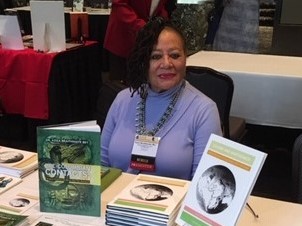Intermarriages of the Tsalagi, Creek, European Settlers, Africans, Catawba, Yuchi, Shawnee and Melungeon in the Southeast before and after the Removal

By Aziza Braithwaite Bey, Ph.D.
The League of Five Nations consisted of the Mohawk, Seneca, Oneida, Onondaga and Cayuga, the Tuscarora joined the Five Nations in 1722 forming The Iroquois Confederacy of Six Nations and from ancient times, the Cherokee nation. Archeologists and linguistic historians have discovered signs of the Tsalagi (Cherokee) immigration from St. Lawrence River Valley and think this migration came from the south through the Appalachians. The Southeastern Cherokee spoke the Iroquoian languages; however, the Iroquois may have broken off from the Cherokee even before the time when the pyramids of Egypt were built (Bastine and Winfield 2011, 7). The living inclusiveness and self-recognition still enjoining Indigenous peoples continues today through non acceptance of imposed “power over,” Indigenous nations and families do not accept those models or attempts to erase their true history (Ywahoo, personal communication March 2019).
A map of the Cherokee Nation before the removal shows the Tsalagi occupied parts of eight states in the southeast; West Virginia, Virginia, North Carolina, South Carolina, Georgia, Alabama, Tennessee and all of Kentucky (Wright 1992, “Map”). It is commonly believed that all Tsalagi, the largest nation living in the Southeast, along with other Native American Nations in neighboring areas, were removed and forced out west to Indian Territory in Oklahoma between 1838 – 39, a period commonly known as the Trail of Tears. At least one thousand Tsalagi refused to leave their homes, stating that the so called chiefs who signed a treaty with the U.S .government agreeing to leave, had no legal right to do so. When the U.S. government waged war against them, many ran up the Great Smokey mountains in Cherokee, N.C., fighting the government who finally ceded the land to those who remained. Others melded with neighboring nations, the Catawba in S.C., the Tuscarora in N.C., the Choctaw in northern Mississippi, the Creek in Alabama and Georgia, “mixed bloods,” of European fathers and Native America mothers, African fathers and Native American mothers and those of three racial ancestries such as the Melungeon, some of Moorish Spanish, Armenian or Portuguese and Native American descent. The intermarriages of the three so called racial groups began at least two centuries before Congress passed the Indian Removal Act of 1830 by one vote. Authors such as William Loren Katz, James Mooney, and William D. Piersen say race (a socially constructed term) mixing began in the early 1600’s. We see on census records many different descriptions for these early intermarriages such as Black Dutch, “mixed bloods” of European and N.A. descent. In the early 1700’s the Yuchi had stolen and enslaved the English, which David H. Corkran discusses in his book Creek Frontier, 1540 – 1783. Immigration rolls of the 1800’s list many English surnames. Those who could pass for European American often did so because of Jim Crow Laws 1877 – 1950s; those of African and Native American (N.A.) descent were often classified as European & N.A. The Civil rights movement of the 1950s ushered in an uprising of lower economic groups composed of Native, African and especially the Irish (Ywahoo, personal communication March 2019). Rarely if ever were tri-racial groups such as the Melungeons cited on the census. Anthropologist James Mooney discusses these early intermarriages in his book Myths of the Cherokee, saying the Cherokee had strains of Creek, Catawba, Uchee, Natchez, Iroquois, Osage, and Shawano blood, (Douglas, K. April/May 2002).
Many Appalachian also intermarried with Native American and Africans; many of them look Indian while others look more European (Redcloud, personal communication).
So who is an Indian, why do so many descendants of Native Americans need to prove they are Indian? Companies such as 23NMe and Ancestry.com have not retrieved Indigenous DNA and as a result are unable to identify which nation you may have descended from. It may show up on your DNA report as Asian as mine did. In some cases nations like the Lumbee and Seminole continue to fight in American courts for recognition, or those who have intermarried into other nations and lost their own customs and languages have become extinct. So we rely on family oral traditions, customs passed down to us from our mother’s and our “blood memory.” Perhaps one day we will embrace ourselves and each other by those inner truths we know, what we hold in our hearts, spirits and memory, recognizing we are all relations and we identify ourselves by the songs in our hearts and the dance that resonates in our souls.
REFERENCES
Bastine, M. and M. Winfield. 2011. Iroquois Supernatural, Animals and Medicine People. Rochester, VT: Bear and Company
Corkran, D. 2016. The Creek Frontier, 1540-1783. University of Oklahoma Press.
Douglas, K. April/May 2002 Remnant Indians of the Southeast. The Multiracial Activist.
Mooney, J. 1996. “Myths of the Cherokee.” Dover Publications, Inc. New York.
Reader’s Digest Association. 1995. Through Indian Eyes: the Untold Story of Native American People.
Redcloud, C. 2017. Personal communication on Cherokee, N.C.
Ywahoo, D. 2019. Personal communication.


